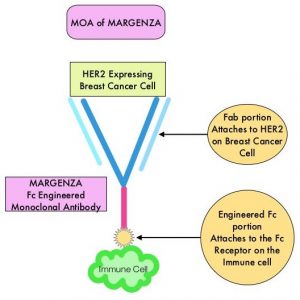Written by Dr. Thomas Hutson, Texas Oncology
Renal cell carcinoma (RCC) is one of the most frequently diagnosed cancers with an incidence of around 400,000 cases worldwide.1 In the United States alone, RCC accounted for 73,820 new cases and 14,770 deaths in 2019.2 In patients with RCC, about 30% present with metastatic disease at the time of initial diagnosis typically requiring systemic therapy, and of those treated for localized RCC, almost 30% develop recurrent disease during the follow-up.3 To address this patient population, multiple targeted therapies focused predominantly on two major molecular pathways, namely angiogenesis and intracellular signal transduction pathways, have gained increasing attention in recent years as prospective therapies for advanced RCC (aRCC).4
The Advent of New Therapeutics for RCC
After the approval of high-dose IL2, there was remarkable progress in the treatment of RCC with approval of VEGF inhibitors, as well as mammalian target of rapamycin (mTOR) pathway inhibitors. These agents have gained regulatory approval and have drastically improved the outcome of patients with advanced RCC.5 More recently, key insights obtained in regard to the Von Hippel-Lindau (VHL) pathway provided the basis for the development of the VHL-hypoxia pathway-based therapeutic landscape in renal cancers.6 For instance, the newer generation tyrosine kinase inhibitors (TKIs) block not only vascular endothelial growth factor receptor (VEGFR) but also fibroblast growth factor receptor (FGFR), and hepatocyte growth factor receptor (C-Met) and Axl, respectively.6 These additional targets have been implicated to help escape angiogenesis blockade which may explain their incremental improvement in efficacy demonstrated in pivotal clinical trials.6 While significant progress has occurred, there is still room for improvement for targeted therapies as current drug interventions for metastatic RCC (mRCC) have yet to demonstrate the ability to circumvent recurrence and several therapies are accompanied by severe adverse events.5
Given that RCC is considered immune-responsive in nature with high numbers of immune cells present in the tumor microenvironment (TME), targeted immunotherapy (IO) was more recently approved as another potential therapy in RCC.7 One strategy involves the use of immune checkpoint inhibitors (ICI). In particular, the use of sophisticated ICIs – anti-programmed death receptor-1 (PD-1), anti-programmed death receptor ligand-1 (PD-L1), and anti-cytotoxic T lymphocytes antigen-4 (CTLA-4) – have been studied in large international phase 3 trials demonstrating significant and clinically relevant improvements in efficacy.4,8 As such, these new therapies have quickly been integrated into the RCC landscape with PD-1 and PD-L1 antibody-based novel ICIs now approved by the FDA as the standard second-line treatment for mRCC as well as in the first-line for moderate to high risk mRCC.9,10
Recently reported and FDA-approved combinations of ICI or ICI with TKI therapy have been rapidly integrated into the first-line treatment setting based upon recent international phase 3 trials.4 It has been proposed that anti-VEGF therapies used in combination with targeted immunotherapies may overcome resistance by modulating the TME. Moreover, inhibition of the VEGF pathway was shown to facilitate access of T-cell population into the TME and decrease the activity of T-regulatory cells and myeloid-derived suppressor cells, thereby enhancing responsiveness to immunotherapy.9,11,12
Strategizing Therapeutic Approach
When patients with mRCC progress through first-line therapies (TKI-ICI, TKI, ICI-ICI), there are many second-line choices to choose from, including ICI, mTOR pathway inhibitors and TKI-mTOR inhibitor combinations.
Before starting therapy, it is necessary to educate the patient about the possibility of adverse reactions that may ensue in the weeks and months after therapy begins. Setting expectations of therapy will serve to maximize patient compliance through early intervention as adverse reactions emerge. This will require close communication between the clinical treatment team, the patient, and their caregivers. Withholding therapy and dose adjustments may be required in some cases to enable patients to remain on therapy.13,14
References
1. Bray F, Ferlay J, Soerjomataram I, et al. Global Cancer Statistics 2018: GLOBOCAN Estimates of Incidence and Mortality Worldwide for 36 Cancers in 185 Countries. CA: A Cancer Journal for Clinicians. 2018;68:394-424
2. Siegel RL, Miller KD, Jemal A. Cancer statistics, 2019. CA Cancer J Clin. 2019;69(1):7-34.
3. Abara E, Chivulescu I, Clerk N, et al. Recurrent renal cell cancer: 10 years or more after nephrectomy. Canadian Urological Association. 2010;4(2):E45-E49.
4. Wang J, Li X, Wu X, et al. Role of immune checkpoint inhibitor-based therapies for metastatic renal cell carcinoma in the first-line setting: A Bayesian network analysis. EBioMedicine. 2019;47:78-88.
5. Barata P, Ornstein M, Garcia J. The Evolving Treatment Landscape of Advanced Renal Cell Carcinoma in Patinents Progressing after VEGF Inhibition. J Kidney Cancer VHL 2017;4(2):10-18.
6. Jonasch E. Implications of VHL-HIF pathway dysregulation in renal cell carcinoma: current therapeutic strategies and challenges. Kidney Cancer Journal. 2020;18(1):6-10.
7. Leite KR, Reis ST, Junior JP, et al. PD-L1 expression in renal cell carcinoma clear cell type is related to unfavorable prognosis. Diagn Pathol. 2015;10:189.
8. Motzer RJ, Escudier B, McDermott DF, et al. Nivolumab versus Everolimus in Advanced Renal-Cell Carcinoma. N Engl J Med. 2015;373(19):1803-1813.
9. Motzer RJ, Penkov K, Haanen J, et al. Avelumab plus Axitinib versus Sunitinib for Advanced Renal-Cell Carcinoma. N Engl J Med. 2019;380(12):1103-1115.
10. Motzer RJ, Tannir NM, McDermott DF, et al. Nivolumab plus Ipilimumab versus Sunitinib in Advanced Renal-Cell Carcinoma. N Engl J Med. 2018;378(14):1277-1290.
11. Rini B.I, Plimack E.R, Stus V, et al. Pembrolizumab plus Axitinib versus
Sunitinib for Advanced Renal-Cell Carcinoma. N Engl J Med. 2019;380:1116-27
12. Suk Lee W, et al. Combination of anti-angiogenic therapy and immune checkpoint blockade normalizes vascular-immune crosstalk to potentiate cancer immunity. Experimental and Molecular Medicine. 2020; 52:1475-1485
13. Philip L. Management of Targeted Therapy Adverse Effects. Pharmacytimes. 2020. https://www.pharmacytimes.com/publications/Directions-in-Pharmacy/2019/December2019/featured-article-management-of-targeted-therapy-adverse-effects. Accessed 10/27/2020.
14. Barber FD. Adverse Events of Oncologic Immunotherapy and Their Management. Asia Pac J Oncol Nurs. 2019;6:212-26
This article is sponsored by Eisai Inc.
LENV-US4722

